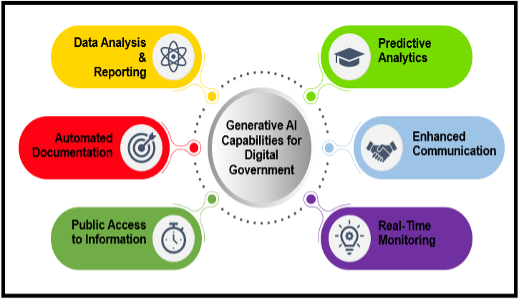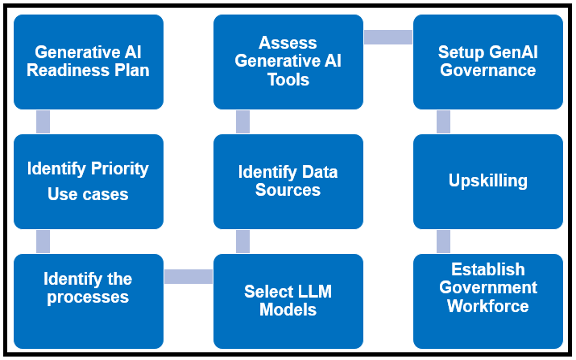
Dr. Gopala Krishna Behara & Prasad Palli
(Part 2 of this article will appear tomorrow.)
Generative Artificial Intelligence Technology is changing the way government serves the Citizens. Generative Artificial Intelligence (Generative AI) refers to the use of AI to create new content, like text, images, music, audio, and videos based on large datasets it has been trained on. Generative AI has huge impact on every industry, every business and every functions. It helps in faster product development, offering cost savings, creativity, enhanced citizen experience, improved government productivity.
Unlike traditional AI, Generative AI can work on unstructured data. It helps in modernizing legacy IT systems to reduce technical debt, and the risk associated with older software.
Government interest in Generative AI has picked up in recent years and many government departments started to invest in AI in the form of pilot programs for various Generative AI based applications. AI adoption acts like a lever for transformational change in the way government services are conceived, designed, delivered & consumed. It helps the Government to provide integrated services to its citizens through seamless flow of information across government departments reducing time required to complete certain tasks and enabling them to focus more time on higher value work. In addition, the adoption of Generative AI helps in improved experiences and significant cost savings, redesign government processes, to free up staff, increase productivity, or improve citizen interactions.
Some of the GenAI capabilities currently used by governments across globe include,
- Chatbots Virtual assistants, agents in citizen services
- Data mapping to geographical areas
- Text recognition and translation
- Natural Language Processing
This guide covers the Government adoption of Generative AI technology, drivers and principles of Generative AI, Capabilities of Generative AI, Generative AI adoption steps for Digital Government and challenges, Generative AI based reference architecture for Digital Government and benefits of Generative AI. It also covers real world Government Use cases in Generative AI technology adoption.
Government Adoption of Generative AI
Digital government is the new Slogan. According to Gartner, “Any organization in any industry, especially those with very large amounts of data, can use AI for business value.” Generative AI is primed to make an increasingly strong impact on enterprises over the next five years.
- Gartner predicts that by 2025, over 50% of government agencies will have modernized critical core legacy applications to improve resilience and agility.
- An analysis by Markets and Markets indicates that the market size of artificial intelligence in military is expected to reach USD 18.82 billion by 2025.
- By 2027, nearly 15% of new applications will be automatically generated by AI without a human in the loop. This is not happening at all today – Gartner
- Intel India VP sales and marketing group, said that the emerging technologies like AI and 5G will play a crucial role in meeting the vison of the government which is “To become a $5-trillion economy in five years”.
Some of the successful implementations of Generative AI in Government Services across different countries and regions that provides efficiency, transparency, and citizen service quality are illustrated below,
United Kingdom Government developed an AI powered voice assistant that provides proactive help with device issues over the phone, showcasing how GenAI enhance public service delivery.
Various U.S. Government Agencies use GenAI to automatically update policy documents, generate conforming guidelines, and revise operational manuals and websites when policies change. Governors of California, Oklahoma and Virginia have issued executive directives designed to address the operational IT, workforce and risk dimensions of Generative AI. Also, the Department of Defense has developed an AI-powered contract-writing capability, called Acqbot, to speed up procurement.
Singapore’s Government has integrated GenAI into its Smart Nation initiative to improve urban planning, traffic management, and public safety. GenAI helps analyze data from various sources to optimize city operations and enhance the quality of life for citizens. Also, GovTech has developed the Pair app, which summarizes text and generates reports for internal use.
Germany Government has launched the Lumi chatbot, the country’s first digital citizen assistant. This tool enables people to easily navigate government services such as applying for a new identity card, getting a driving license, and registering a place of residence.
Australia’s New South Wales Government uses GenAI to streamline service delivery. AI-powered chatbots assist citizens with inquiries about government services, reducing wait times and improving the overall efficiency of service delivery.
Canadian Government regulatory bodies use GenAI tools to analyze large datasets, identify trends, and generate reports. This helps in making informed decisions more efficiently and effectively.
Business Case for Government Selection of Generative AI
The following strategy level questions help to understand about the government readiness for the Generative AI adoption.
- How does the Generative AI help in enhancing existing processes and government vision
- Is there an internal business case built at department level? If so, at what level
- Which business processes have greatest potential to offer value to citizens and employees based on adoption of Generative AI
- What is the degree of perimeter security required
- Is the platform compliant with Generative AI guidelines
- Is platform available domestically
- What models does the preferred platform support
- How and from where is the data gathered
- Which departments and business functions are best suited for Generative AI adoption
- How Government Schemes and Policies are performing and Why
- How to gauge sentiments of people of the government and their perceptions and attitudes towards government policies
- How to improve Citizen Satisfaction through participation in decision-making
- Need to understand the resources required for effective Generative AI adoption
- What kind of capabilities should Generative AI support
- Who manages output generated by Generative AI
Drivers for AI Adoption in Digital Government
Digital Government is the New Slogan. The following are the drivers for GenAI adoption in Government,
- Citizen demands and expectations, GenAI can support critical citizen capabilities. These include improving situational awareness and decision-making.
- Modernize the Citizen services, Citizen-facing applications improves the quality of services government deliver to citizens.
- For example, AI can improve patient outcomes by analyzing individual patient information to personalized treatment
- Innovation in Government Services, by automating simple, well-defined tasks, AI streamlines operations and augments the workforce. Employees can then spend more time on decisions that require human input.
- For example, the usage of computer-generated virtual assistant can reduce time spent replying to basic inquiries, while predictive analytics enables more informed decision-making.
- Data driven decision making, Governments are collecting an abundant amount of data from social media platforms every day. Without an accurate analysis, data is not adequate for actionable insights. Generative AI tools can be used to analyze data accurately, address citizen grievances by intelligent routing to the right stakeholder. Generative AI can provide precise and personalized information to a citizen and help in proactive citizen service delivery. Better decision making has the potential to both improve services and save time.
- For example, GenAI can enhance the user experience for passengers by using historical and real-time data to predict demand and ensure that services are always available at the right time.
- Improve operational efficiency, automation of government employee tasks leads to saving of cost, time and effort.
Addressing these drivers requires Government reference Generative AI based architecture, Government governance frameworks, continuous monitoring, and citizen engagement to ensure that GenAI implementations are ethical, transparent, and effective.
Capabilities of Generative AI for Digital Government
Generative AI significantly enhances transparency in Government operations through several key capabilities.
- Data Analysis and Reporting: Generative AI can process vast amounts of data to generate clear, understandable reports on government activities, budgets, and expenditures. This helps citizens and oversight bodies track how public funds, citizen schemes are being used.
- Automated Documentation: By automating the creation and dissemination of departmental documents, Generative AI ensures that information is consistently and accurately recorded and shared. This reduces the risk of human error and intentional manipulation.

Figure 1: Generative AI Capabilities
- Public Access to Information: Generative AI can power chatbots and virtual assistants that provide citizens with easy access to information about government services, policies, and procedures. This makes it easier for citizens to find the information they need without navigating complex bureaucratic systems.
- Predictive Analytics: By analyzing trends and patterns, Generative AI can predict potential issues in government operations before they become significant problems. This proactive approach allows for timely interventions and increased accountability.
- Enhanced Communication: Generative AI can facilitate better communication between government agencies and the public. For example, it can generate summaries of legislative changes or policy updates making them more accessible to the public.
- Real-Time Monitoring: Generative AI can be used to monitor government projects and initiatives in real-time, providing updates on progress and flagging any deviations from planned timelines or budgets. This ensures that projects remain on track and that any issues are promptly addressed.
By leveraging these capabilities, Generative AI can help create a more transparent, accountable, and responsive government. This helps in establishing more public trust and involvement.
Generative AI Adoption Steps for Digital Government
The following are the steps to follow for Generative AI adoption by the Digital Government.

Figure 2: Generative AI Adoption Steps
- Generative AI Readiness Plan: Establish an executive team for identifying and overseeing the AI initiatives across the Government. Define a clear vision and strategy for Generative AI implementation aligned with the Government goals and citizen specific functions. Develop plan to mitigate the risks of using Generative AI covering internal policies, guidelines, and awareness sessions.
- Identify Priority Use cases: Not every usecase requires Generative AI. Identify the business challenges that require attention. Also, understand the business benefits of Generative AI adoption that are critical for the success of the Government. Select the targeted use cases according to potential impact and feasibility that deliver desired outcomes. Build value through improved productivity, growth, and new business models.
- Identify the Processes: Understand the impact of Generative AI solutions and determine its success measurement. Create the processes for ongoing monitoring and auding of Generative AI systems for responsible use of AI to ensure compliance with legal, technical standards.
- Select LLM Models: Start with an off-the-shelf LLM and fine-tune it with proprietary data and integration with internal systems to deliver customized results. If not available in registry, develop and train a new LLM model.
- Identify Data Sources: Enable access to quality data by processing both structured and unstructured data sources. Defne data access controls, data sharing agreements and data lifecycle management procedures for Generative AI systems.
- Assess Generative AI Tools: Evaluate Generative AI tools for the Government. The tool needs to adhere to the government standards like security, privacy, data handling and compliance. The tool needs to empower the stakeholders to deliver citizen needs and continuously improve the experiences it generates against government metrics.
- Generative AI Governance: Setup Generative AI Governance across Government. Establish Head of AI across Government. Define roles and responsibilities of individuals involved in Generative AI development, deployment and monitoring. Define AI engineers, AI ethics officers, or prompt engineers across Government. Foster the collaboration between AI experts, domain experts and government stakeholders. Establish a centralized, cross-functional team to review and update Generative AI governance practices as technology, regulations and government needs.
- Upskilling: Reskill the government employees to improve productivity by conducting various training courses and encourage them to perform POCs. Also, based on role and skills of employees, identify the skill gaps and train them effectively to contribute better ways to the government transformation initiatives.
- Establish Government Workforce: Educate government employees in the usage of Generative AI technologies, their usage across government systems, challenges of usage of Generative AI and how to overcome them. Conduct structured training to build new skills and apply new ways of thinking that deliver better experiences to end users. Formulate a detailed communication mechanism to understand Generative AI technologies and their implications to ensure safe adoption.
Acknowledgements
The authors would like to thank Tanay Srivastava, Director, Tricon Solution LLC for giving the required time and support in many ways in bringing up this Guide as part of Technical Services efforts.
About Authors
Dr. Gopala Krishna Behara is an Enterprise Architect at Tricon IT Solutions. He has around 28 years of IT experience. He can be reached at gopalakrishna.behara@triconitsolutions.com.
Prasad Palli is Principal Enterprise Architect at Albertsons Companies. He has around 25+ years of IT experience. He can be reached at palli_prasad@hotmail.com
Disclaimer
The views expressed in this article/presentation are that of authors and Tricon Solutions & Albertsons does not subscribe to the substance, veracity or truthfulness of the said opinion.
